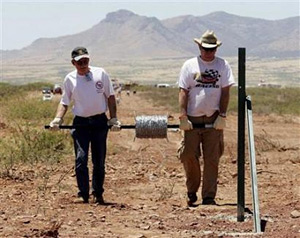 |
 |
 |
 News Around the Republic of Mexico | May 2006 News Around the Republic of Mexico | May 2006  
Braving Heat and Harsh Terrain, Some Mexican Migrants Take to Bicycling into U.S.
 Mark Stevenson - Associated Press Mark Stevenson - Associated Press


| | Volunteers with the Minuteman Civil Defense Corps run barbed wire along a fence line the group is building 50 feet from the U.S. border with Mexico on the San Jose Ranch in Palominas, Arizona. (Jeff Topping/Reuters) |
Sonoyta, Mexico – Many illegal immigrants no longer hike. They bike.

The 110-degree heat and rough terrain of the Arizona desert would exhaust the fittest of cyclists, but these migrants are often middle-aged housewives or farmers, riding battered second-hand bikes for 30 or 40 miles.

The bikes also carry their supplies and belongings, so if rocks or cactus spines shred the tires, they get off and push.

The prize? A chance at a low-wage job.

“We've seen them going by on bicycles right by our offices ... in whole groups,” said Mario Lopez, an agent for Mexico's Grupo Beta migrant aid agency, whose offices sit just a few hundred yards from the border. “They're usually old bikes because they're going to abandon them anyway.”

Most start their trip in Sonoyta, a Mexican border town where the bikes are sold for $30 in a dusty, vacant lot a few blocks from the chest-high, three-rail fence that marks the U.S. border. The fence has prevented vehicles from driving across into the Organ Pipe Cactus National Monument, but migrants can easily toss a bike over and slip through the rails.

From there, it's a brutal ride over Organ Pipe's hard-packed terrain. Though the park prohibits off-road biking, sets of fresh mountain-bike tracks can be seen running down its foot trails, and the National Park Service often finds abandoned bikes with crumpled wheels and water bottles hanging off the handlebars.

Fred Patton, the park's chief ranger, says “hundreds and hundreds and hundreds” of migrants bike through the park. No count is kept and he can't be precise, but he provides pictures of abandoned bikes. “It's a relatively common means of transport,” he said.

The aid group Humane Borders, which combs the Arizona desert for migrants needing help, says it often stumbles across abandoned bikes, their tires flat.

Many migrants simply ditch the bikes when they get to a prearranged meeting point, where a smuggler is waiting with a vehicle to whisk them away to a nearby city.

Some 500 deaths were reported last year of migrants who succumbed to heat and thirst while trying to cross the desert on foot. No evidence has turned up cyclists suffering the same fate.

The off-road course proved too grueling for Alejandra Valenzuela, 27, who fell behind with another woman.

“It was ugly, it was horrible,” she said. “We were stuck in the park and nobody wanted to help us.”

Valenzuela and the other migrant woman eventually reached a highway where they waited for the Border Patrol to find them and send them back to Mexico.

While bicycles may ease the journey through the 500-square-mile park, the ride is not for the faint of heart.

“It's mostly impossible,” Patton says.

But migrants don't fall into the faint-of-heart category.

“They tie their water and their possessions on top of the bikes, and just push them till the rims are square,” said park ranger Viv Sartori.

Associated Press writer Julie Watson in Mexico City contributed to this report. | 
 | |
 |



